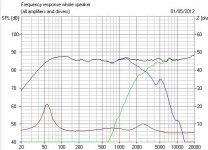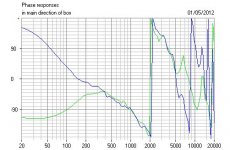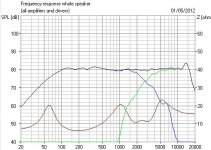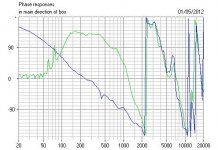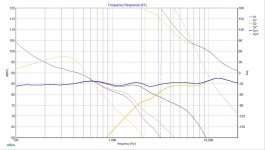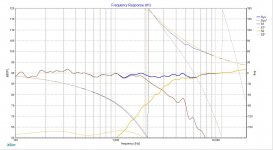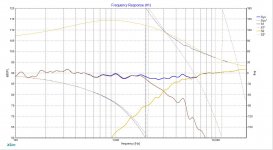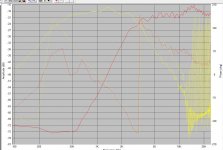I'd like to get some opinions on phase tracking around a crossover point:
How important is it?
How closely does phase between drivers need to track and for how many octaves before and after the crossover point?
What are the audible characteristics of a good / poor phase tracking between drivers?
Does anyone think it's NOT important, as long as the crossover sums to a reasonably flat frequency response?
How important is it?
How closely does phase between drivers need to track and for how many octaves before and after the crossover point?
What are the audible characteristics of a good / poor phase tracking between drivers?
Does anyone think it's NOT important, as long as the crossover sums to a reasonably flat frequency response?
I would think its quite audible, from my little experience, it seems to sound indistinct and coloured in the xover region. After a few minor tweeks the improvements can be heard as a more pronounced, accurate and forward midrange, not to mention much better imaging and depth.
My 2c.
My 2c.
The importance of phase tracking is that it determines frequency response through crossover and how it varies off axis. You can, for example have a near constant 90 degrees shift between units and get flat response on your desired axis, but response will have to peak a little in one direction and quickly fall into a hole in the opposite direction (off axis in the plane containing both drivers, usually the vertical plane).
For the most part you will get a flatter system response if you can get the phases close. If they cross at a strong angle then you are certain to have ripple in the summed response as they will swing from adding to subtracting within the crossover region.
More than anything the audible effect will be the impact of phase blend on the combined frequency response. Others will try and mystify the phase effect, but should remember that the overall phase response of the system is minimally changed by the phase spread between two units. The combined phase response in the crossover region is essentially half way between the two starting phase curves (it transitions smoothly from one to the other) and improving the phase "closeness" doesn't change the overall group delay of the system (these are facts).
If one or the other unit is 20dB down, then it will add at most 0.8dB to the total (phase depending). So that is a good rule of thumb: strive for a phase difference of less than 90 degrees over the range where either unit is within 20dB of the other. Try and get within 30 degrees at the middle of the crossover region.
Regards,
David S.
For the most part you will get a flatter system response if you can get the phases close. If they cross at a strong angle then you are certain to have ripple in the summed response as they will swing from adding to subtracting within the crossover region.
More than anything the audible effect will be the impact of phase blend on the combined frequency response. Others will try and mystify the phase effect, but should remember that the overall phase response of the system is minimally changed by the phase spread between two units. The combined phase response in the crossover region is essentially half way between the two starting phase curves (it transitions smoothly from one to the other) and improving the phase "closeness" doesn't change the overall group delay of the system (these are facts).
If one or the other unit is 20dB down, then it will add at most 0.8dB to the total (phase depending). So that is a good rule of thumb: strive for a phase difference of less than 90 degrees over the range where either unit is within 20dB of the other. Try and get within 30 degrees at the middle of the crossover region.
Regards,
David S.
Yes - very interesting Dave!
In my current project I have a cone mid and a horn tweet. There is about 5" difference in acoustic centers.
How can I correct that time alignment? I don't recall the exact numbers off-hand, but that distance is very near the wavelength of the crossover freq. This puts everything in phase at exactly the crossover freq, but as the sound varies in freq above and below the crossover freq. it seems like the phase will vary drastically, because everything is 360 degrees out of phase, and the time alignment is so far out.
Do you know how this will affect the sound, and any possible solutions?
In my current project I have a cone mid and a horn tweet. There is about 5" difference in acoustic centers.
How can I correct that time alignment? I don't recall the exact numbers off-hand, but that distance is very near the wavelength of the crossover freq. This puts everything in phase at exactly the crossover freq, but as the sound varies in freq above and below the crossover freq. it seems like the phase will vary drastically, because everything is 360 degrees out of phase, and the time alignment is so far out.
Do you know how this will affect the sound, and any possible solutions?
Your question gets to the fundamentals of crossover design. We need to control not just the response and rolloff rate but also the phase curve.
Horn sysems ar a little more complex because they usually have the treble end more delayed than the bass end. This is a little at odds with the normal systems where phase fall off for the LF side more naturally mates with phase rise of the HF side.
Time disparity between sections is seen as a big slope difference of the phase curve at crossover. For passive networks all you can do is increase the crossover order for the side that needs more phase bending. Increasing order adds more phase bending downwards for the LF side and upwards for the HF side. If the time discrepency isn't too great then you might get there with a network of a reasonable order.
There was a link on the forum a couple of weeks ago by a guy that used 5th or 6th order to get time allignment (at crossover) for the delayed treble element of an Altec 605 coax.
Poor time allignment at crossover, as described above, will give phase rotations and comb filtering through the crossover region. You tend to hear the frequency of the lower peaks of the periodic ripple. For tough cases DSP with adjustable delay is a very clean solution.
David
Horn sysems ar a little more complex because they usually have the treble end more delayed than the bass end. This is a little at odds with the normal systems where phase fall off for the LF side more naturally mates with phase rise of the HF side.
Time disparity between sections is seen as a big slope difference of the phase curve at crossover. For passive networks all you can do is increase the crossover order for the side that needs more phase bending. Increasing order adds more phase bending downwards for the LF side and upwards for the HF side. If the time discrepency isn't too great then you might get there with a network of a reasonable order.
There was a link on the forum a couple of weeks ago by a guy that used 5th or 6th order to get time allignment (at crossover) for the delayed treble element of an Altec 605 coax.
Poor time allignment at crossover, as described above, will give phase rotations and comb filtering through the crossover region. You tend to hear the frequency of the lower peaks of the periodic ripple. For tough cases DSP with adjustable delay is a very clean solution.
David
Last edited:
1st order slopes just don't do phase alignment at crossover. 🙄
2nd order Linkwitz-Riley slopes work very nicely on phase with or without time alignment.
The classic BBC LS3/5A and KEF R101 2nd order bass and 3rd order tweeter crossovers also work very well on a regular baffle. They are masterpieces well worth studying.
You have to carefully adjust the Q of the filters to get it just right. 😎
2nd order Linkwitz-Riley slopes work very nicely on phase with or without time alignment.
The classic BBC LS3/5A and KEF R101 2nd order bass and 3rd order tweeter crossovers also work very well on a regular baffle. They are masterpieces well worth studying.
You have to carefully adjust the Q of the filters to get it just right. 😎
Attachments
If using dsp with delay to solve known time alignment problems, what method should one use to incorporate it into crossover design? For example, I would guess that one would first find the proper delay value before moving into crossover slope choice. I've heard of use of ETC as well as group delay calculations to figure out the delay value, but I've not used either yet.
Thanks,
John
Thanks,
John
In my current project I have a cone mid and a horn tweet. There is about 5" difference in acoustic centers.
I've found in dealing with this in one example, I've arrived at three orders more for the lower driver such as 4th, and 1st on the tweeter. However the difference between an extra component can be undermined by the circumstances ie: f, Q and Z. For example you might succeed with 3rd on the woofer, with some impedance flattening and 2nd on the tweeter, if you were to add a series notch filter across the woofer whose influence is mainly in the phase domain and not the frequency response.
Probably several ways to approach DSP allignment and achieve a good result. I would be tempted to add the high pass and low pass filters that gave a combined response (driver and network combined) that looked most like a Linkwitz Riley shape and then just adjust time delay while watching the combined frequency response. Most DSP programs let you fine tune delay and it should be very easy to see what particular delay gave the best sum, especially if you can adjust the delay on the fly.
The problems with looking at ETC is it tends to direct you to allign delay for the middle of the woofer's range relative to the middle of the tweeter's range, etc. You really need to get allignment for the crossover region, rather than the driver's mid sections.
Nice examples of phase overlap, Steve.
David S.
The problems with looking at ETC is it tends to direct you to allign delay for the middle of the woofer's range relative to the middle of the tweeter's range, etc. You really need to get allignment for the crossover region, rather than the driver's mid sections.
Nice examples of phase overlap, Steve.
David S.
The importance of phase tracking is that it determines frequency response through crossover and how it varies off axis. You can, for example have a near constant 90 degrees shift between units and get flat response on your desired axis, but response will have to peak a little in one direction and quickly fall into a hole in the opposite direction (off axis in the plane containing both drivers, usually the vertical plane).
For the most part you will get a flatter system response if you can get the phases close. If they cross at a strong angle then you are certain to have ripple in the summed response as they will swing from adding to subtracting within the crossover region.
More than anything the audible effect will be the impact of phase blend on the combined frequency response. Others will try and mystify the phase effect, but should remember that the overall phase response of the system is minimally changed by the phase spread between two units. The combined phase response in the crossover region is essentially half way between the two starting phase curves (it transitions smoothly from one to the other) and improving the phase "closeness" doesn't change the overall group delay of the system (these are facts).
If one or the other unit is 20dB down, then it will add at most 0.8dB to the total (phase depending). So that is a good rule of thumb: strive for a phase difference of less than 90 degrees over the range where either unit is within 20dB of the other. Try and get within 30 degrees at the middle of the crossover region.
Regards,
David S.
That's very helpful. Thanks Speaker Dave
There was a link on the forum a couple of weeks ago by a guy that used 5th or 6th order to get time allignment (at crossover) for the delayed treble element of an Altec 605 coax.
http://web.mac.com/donaldpatten
The low pass is a tenth order Bessel to get the proper constant delay.
If you inspect the freq resp curves, there is no bump up at XO , and smooth gradual slopes , around XO.
http://web.mac.com/donaldpatten
The low pass is a tenth order Bessel to get the proper constant delay.
If you inspect the freq resp curves, there is no bump up at XO , and smooth gradual slopes , around XO.
Take a look please
Sorry to revive an old thread but I'm not sure if I can start a new one(and didn't know how). I have been using X-Sim for awhile now but am just now realizing the importance of phase tracking. Can someone take a look at these and see if Phase is good and if not, maybe give me some info or tips on what to look for? Thanks
Sorry to revive an old thread but I'm not sure if I can start a new one(and didn't know how). I have been using X-Sim for awhile now but am just now realizing the importance of phase tracking. Can someone take a look at these and see if Phase is good and if not, maybe give me some info or tips on what to look for? Thanks
Attachments
It looks OK. You can't do a great deal with phase, with a single measurement per driver approach other than to see they are near each other, say within 90 degrees.
my understanding is, get the amplitude as close as possible to your acoustic target.
trouble is, i see a lot of crossover talk where the acoustic output is not mentioned.
get the acoustic target right and the phase will be correct i.e. if the output is LR4 the phase is LR4.
then, delay caused by driver offset and the action of the crossover filter can then be dialled in.
trouble is, i see a lot of crossover talk where the acoustic output is not mentioned.
get the acoustic target right and the phase will be correct i.e. if the output is LR4 the phase is LR4.
then, delay caused by driver offset and the action of the crossover filter can then be dialled in.
Attachments
Thanks AllenB. These are three different crossovers. I'm wondering which one is the best as far as phase is concerned? My guess is XO-2-phase? When each driver phase curve switches from -180 to +180(vertical lines) is it best to have those as close as possible or even overlapping being the best? Is XO-1 not as good as XO-2 because the vertical lines are farther apart in the crossover region? Sorry for all the dumb questions but I am fairly new to this and want to make sure I am looking for the right things in X-SIM as far as phase is concerned. Thanks for the help.
- Home
- Loudspeakers
- Multi-Way
- The importance of phase tracking
